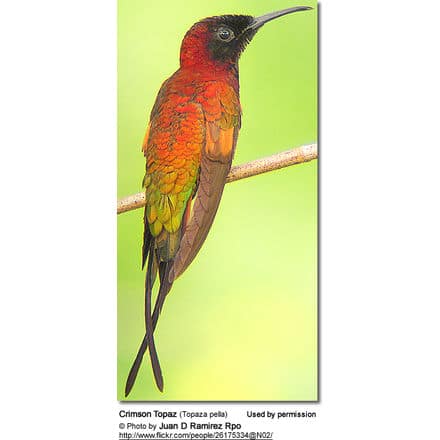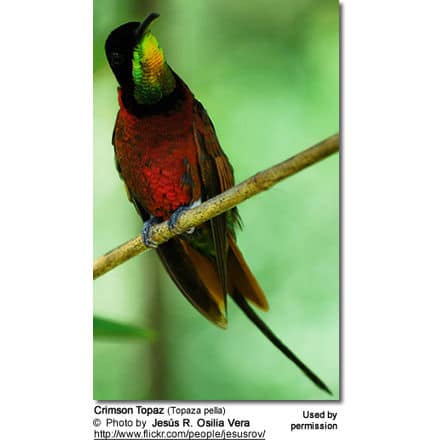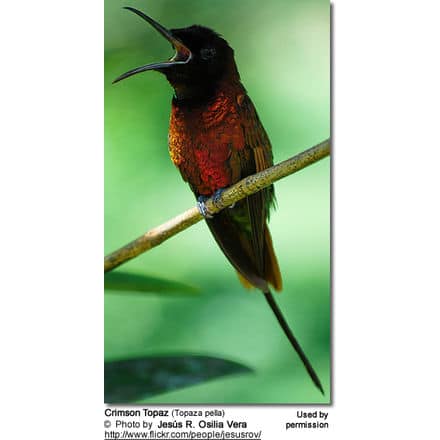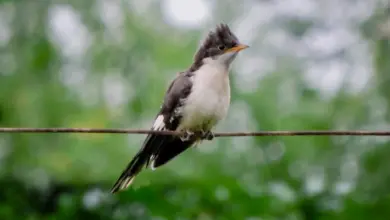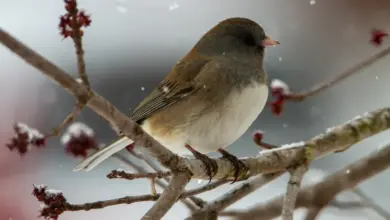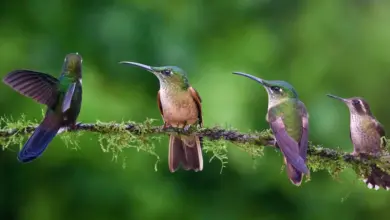Topazes (Hummingbirds)
Hummingbird Information
The Topazes (genus Topaza) – also known as “Topaz Hummers” or “Topaz Hummingbirds” – consists of two resident South American hummingbird species.
Distribution
Topazes are found in the humid forests of the
- Amazon Basin (located mainly in Brazil, but also stretches into Peru and several other countries); and the
- West Indies (the latter is situated between North and South America, curving from Florida to the coast of Venezuela.
Topazes are mainly sedentary (non-migratory), but they may perform seasonal movements according to the flowering seasons within their range.
Species
- Crimson Topaz (Topaza pella) – Range: Brazil, French Guiana, Guyana, Suriname and Venezuela
- Fiery Topaz (Topaza pyra) – Range: Ecuador, Peru, Colombia, Brazil and Venezuela
Note: Some consider the Fiery Topaz a subspecies of the Crimson; however, nowadays most mainstream authorities consider them separate species.
Description
The Topazes are large, brilliantly colored humming birds. Male Topazes are the second-largest hummingbirds (the largest being the Giant Hummingbird of the Andes). Males average 22 cm (8½ in) in length; however, this includes their long tail feathers.
The male’s most striking features are the two tail feathers next to the central feathers, which are much longer that the rest, curved, and crossed; as well as the metallic yellowish-green throat with a golden brown to yellow sheen in the center. The iridescence of his plumage is used to attract females and in defensive situations.
Their head is most a deep black. They have a mostly red plumage tinted orange and rose in various areas. The abdomen is red with a hint of rose. The back is bright red. The male’s flashy-colored plumage is used to signal identity and dominance.
Females are a little smaller in size than the males; their plumage is mostly green; and they don’t have the elongated tail feathers that can be seen on the males.
Calls / Vocalizations
They make high-pitched chirps and whistles. Their contact or defense calls are often short. Their aggression / chase calls are described as a series of rapid chattering.
Nesting / Breeding
They usually breed twice a year – the first season may start in January and go on until April, and the second is from July through November. However, the breeding season varies according to the range.
Hummingbirds in general are solitary and neither live nor migrate in flocks; and there is no pair bond for this species – the male’s only involvement in the reproductive process is the actual mating with the female.
During the breeding season, the male Topaz exposes his flashy-colored throat. The iridescence of its plumage is used in attracting the attention of females, or as a way to warn territorial intruders.
He will separate from the female immediately after copulation. One male may mate with several females. In all likelihood, the female will also mate with several males. The males do not participate in choosing the nest location, building the nest or raising the chicks.
The female is responsible for building the cup-shaped nest out of pale- colored plant fibers, often of Bombax seeds, woven together and green moss on the outside for camouflage in a protected location in a shrub, bush, tree or vines, about 10 – 26 feet (or 3 to 8 meters) above or near water. The small nest measures about half the length of the female and appears small compared to her. She lines the nest with soft plant fibers, animal hair and feather down, and strengthens the structure with spider webbing and other sticky material, giving it an elastic quality to allow it to stretch to double its size as the chicks grow and need more room.
The average clutch consists of two white eggs, which she incubates alone for about 14 to 23 days (exact time is not known), while the male defends his territory and the flowers he feeds on. The young are born blind, immobile and completely helpless. The chicks are black with a scarce pale grey down on the back.
The female alone protects and feeds the chicks with regurgitated food (mostly insects since nectar is an insufficient source of protein for the growing chicks). As is the case with other hummingbird species, the chicks are brooded only the first week or two, and left alone even on cooler nights after about 12 days – probably due to the small nest size. The chicks leave the nest when they are about 21 days old, but will be cared for by the female for another 3 weeks. The offspring attains its adult plumage and reaches sexual maturity in the second year.
Diet / Feeding
The male establish feeding territories which they defend by calling out to the intruders and flashing their bright colors towards them.
They primarily feed on nectar taken from a variety of brightly colored, scented small flowers of trees, vines, shrubs and epiphytes found in the canopy of the forest.. They are often observed visiting the flowers of the Bromeliaceae and Ericaceae. In some areas (such as the Surinam), they forage near the ground.
They favor flowers with the highest sugar content (often red-colored and tubular-shaped) and seek out, and aggressively protect, those areas containing flowers with high energy nectar. They use their long, extendible, straw-like tongues to retrieve the nectar while hovering with their tails cocked upward as they are licking at the nectar up to 13 times per second. Sometimes they may be seen hanging on the flower while feeding.
Many native and cultivated plants on whose flowers these birds feed heavily rely on them for pollination. The mostly tubular-shaped flowers actually exclude most bees and butterflies from feeding on them and, subsequently, from pollinating the plants.
They may also visit local hummingbird feeders for some sugar water, or drink out of bird baths or water fountains where they will either hover and sip water as it runs over the edge; or they will perch on the edge and drink – like all the other birds; however, they only remain still for a short moment.
They also take some small spiders and insects – important sources of protein particularly needed during the breeding season to ensure the proper development of their young. Insects are often caught in flight (hawking); snatched off leaves or branches, or are taken from spider webs. A nesting female can capture up to 2,000 insects a day.
Males establish feeding territories, where they aggressively chase away other males as well as large insects – such as bumblebees and hawk moths – that want to feed in their territory. They use aerial flights and intimidating displays to defend their territories.
Metabolism and Survival and Flight Adaptions – Amazing Facts
Species Research by Sibylle Johnson
Please Note: The articles or images on this page are the sole property of the authors or photographers. Please contact them directly with respect to any copyright or licensing questions. Thank you.

